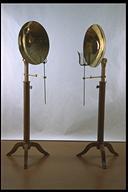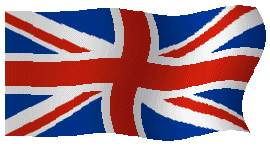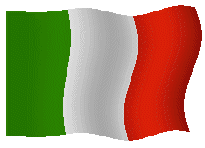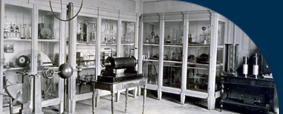|
OUR COLLECTION OF SCIENTIFIC INSTRUMENTS
HEAT |

 |
Conjugated parabolic mirrors |
 |
Specchi parabolici coniugati |
| Subjects: heat, acoustics/propogation and reflection of heat and sound |
Settore: calore, acustica/propagazione e riflessione del calore e del suono |
| Inventory Number: 258 - 259 |
Numero di inventario: 258 - 259 |
| Achille Scateni [historical inventory] |
Achille Scateni [inventario storico] |
| 1860 [historical inventory] |
Periodo di costruzione: 1860 [inventario storico] |
| Beech, brass, iron |
Materiale utilizzato: Noce, ottone, ferro |
| Parabolic mirror: Ø 470 mm; Height: max 1860 mm, min. 1490 mm |
Dimensioni: Specchio parabolico Ø 470 mm; altezza: max. 1860, min. 1490 mm |
| |
|
This pair of metal mirrors, which were very often used in the didactic activity of the scientific laboratories of the 19th century, showed that “radiant heat” spreads and reflects following the same laws of light. These mirrors were later used even for the study of sound propagation. The property of revealing the “laws of heat”, focusing heat from one mirror to the other placed at a given distance, had been highlighted in the second half of the eighteenth century by the Swiss physicists Marc Pictet (1752-1825) H. B. De Saussure (1740-1799), and by the Swedish chemist Carl Wilhelm Scheele (1742-1786). Pictet, in particular, imagined an experiment in which the two concave mirrors were placed at a distance of twenty-four feet from one another and in which an incandescent piece of coal was placed in the focus of one mirror, thereby setting fire to a combustible object placed in the focus of the other. |
Questa coppia di specchi metallici, di uso didattico molto frequente nei gabinetti scientifici del XIX secolo, mostrava che il “calore raggiante” si propaga e si riflette con le stesse leggi della luce. In seguito essi vennero impiegati anche per lo studio della propagazione del suono. La proprietà di mostrare le “leggi del calorico”, focalizzando del calore da uno specchio ad un altro posto ad una certa distanza, era stata messa in evidenza, già nella seconda metà del settecento, dai fisici svizzeri Marc Pictet (1752-1825), H-B De Saussure (1740-1799) e dal chimico svedese Carl Wilhelm Scheele (1742-1786). Pictet, in particolare, immaginò l’esperienza dei due specchi concavi messi a ventiquattro piedi di distanza l’uno dall’altro ed in cui nel fuoco dell’uno si poneva un carbone incandescente che infiammava un corpo combustibile posizionato nel fuoco dell’altro. |
| |
|
Description: each part is nicely manifactured with a base having a beech tripod whose height can be adjusted and on the top of which there is a concave reflecting mirror, which is entirely made of brass and which can be moved by means of a joint in the back. Each mirror has a smooth and varnished internal surface, whereas the ....is darkened; it has a diameter of 474 mm and the shape of a revolution paraboloid with the focus placed along its own axis of symmetry. A brass arm, horizontally fixed to the mobile axis of the base and whose length is adjustable, enables to fix in the focus of the first mirror a basket made of a metal net containing incandescent coal, which acts as source of heat, and in the focus of the other a overturned tripod, also made of metal, acting as a heat detector by means of a piece of cloth soaked in alcohol or by the use of some phosphorum or any other kind of inflammable material. |
Descrizione: ciascun pezzo, ben lavorato, si compone di un sostegno con tripode in noce regolabile in altezza e portante sulla sua sommità uno specchio riflettore concavo, completamente d’ottone, orientabile tramite uno snodo posteriore. Ciascuno specchio presenta la sua superficie interna ben levigata e laccata mentre l’esterna è brunita; ha un diametro di 474 mm e la forma di un paraboloide di rivoluzione con il fuoco posizionato lungo il proprio asse di simmetria. Un braccio d’ottone, fissato orizzontalmente sull'asse mobile del sostegno e regolabile in lunghezza, permette di fissare nei fuochi degli specchi rispettivamente un cestello porta carboni ardenti in rete metallica, che funge da sorgente di calore e un tripode rovesciato, anch'esso metallico, che agisce come rivelatore termico tramite il posizionamento di un panno imbevuto d'alcool o di un pezzo di fosforo o di altro materiale facilmente infiammabile. |
| |
|
Function: the two mirrors are placed one opposite the other with the two axes coinciding at a few meters of distance; the “radiant heat” (infra-red rays) produced by incandescent coal is reflected in the first mirror, moves parallel to the axis and is reflected in the focus of the second mirror, thereby causing, after a while, the ignition of the inflammable material. A similar experiment of acoustics consists of placing a clock in the first focus: in this way one clearly perceives its ticking in the focus of the second mirror. |
Funzionamento: si pongono i due specchi di fronte l'uno all'altro con gli assi coincidenti ad una distanza di qualche metro; il "calore raggiante" (raggi infrarossi), prodotto dai carboni ardenti, riflettendosi sul primo specchio e viaggiando parallelamente all'asse va a concentrarsi nel fuoco del secondo specchio provocando, dopo qualche istante, l'accensione del materiale infiammabile. Una analoga esperienza d'acustica consiste nel porre un orologio nel primo fuoco e nel percepire distintamente il suo ticchettio nel fuoco del secondo specchio. |
| |
|
Bibliography: Hoefer [1872], pp. 159-160; Ganot [1873], pp. 322-323. |
Bibliografia: Hoefer [1872], pp. 159-160; Ganot [1873], pp. 322-323. |
|
|
|

